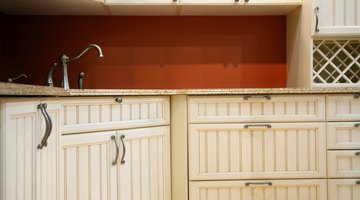How to Make Beadboard Cabinet Doors
Beadboard is a natural choice for informal interiors such as country cottages and farmhouses. It is applied to walls and furnishings, including cabinets, with the characteristic grooves running vertically. Old-fashioned beadboard is formed with interlocking tongue-and-groove strips similar to flooring.

However, beadboard sheets are naturally straight and square, making it a less challenging material for building straight cabinet doors. Paint the finished doors or stain and seal them to match your cabinet.
-
Measure the cabinet opening horizontally and vertically.
-
Measure across the longer edge of the plywood to the vertical measurement plus 1 inch and make a pencil mark. Measure across the perpendicular edge of the plywood to the horizontal measurement plus 1 inch and make a pencil mark. Repeat using the beadboard.
-
Place one leg of a framing square against the edge of the plywood with the corner at a pencil mark and the other leg extended over the surface. Trace the edge of the square across the plywood with a pencil to make a line. Repeat on the perpendicular edge at the other mark to make another line. Repeat using the beadboard.
-
Align a yardstick with a pencil line on the plywood. Trace its edge with a pencil to extend the line. Use the yardstick in the same manner at the other line to make the two lines meet. Repeat using the beadboard.
-
Cut the plywood and the beadboard at the lines using a circular saw. Sand the rough edges of both pieces.
-
Pour wood glue into a small paint tray. Roll the small paint roller through the glue several times to saturate the foam. Set the plywood on a flat work surface. Roll a thick coat of glue on one side of the plywood and on the back or plain side of the beadboard. Let the glue dry until it is tacky or sticky.
-
Set the beadboard on top of the plywood with the glued sides together. Cover the beadboard with a sheet of craft paper. Iron the paper with a medium iron. Set flat, heavy objects, such as encyclopedias, on the beadboard door for 24 hours.
-
Remove the objects and sand the dried glue off the edges of the door.
-
Choose the location for your cabinet pull or knob on the edge of the door that will open. There is no rule that governs pull location. Set one pull on the door and mark the screw hole location on the door with a pencil. Drill the bolt hole through the door at the pencil mark. Slip the bolt through the hole from the back side. Set the pull on the end of the bolt and twist to tighten them.
Things You Will Need
- Measuring tape
- 1 sheet furniture-grade plywood, 4-by-8, 1/2-inch thick
- Pencil
- 1 sheet bead board, 4-by-8
- Framing square
- Yardstick
- Circular saw
- Fine sandpaper
- Wood glue
- Small paint tray
- Small foam paint roller
- Craft paper
- Iron
- Weighted objects
- Power drill
- Cabinet pull
Tip
Install the hinges and hang the door based on the type of hinges that you desire. Conceal the edges of the door with screen molding or narrow, iron-on wood veneer. Frame the surface of the door with 2- or 3-inch wood molding.
Warning
Using wood clamps instead of weighted objects can cause the door to curve as it dries.
References
Writer Bio
Lee Carroll has been a freelance writer for nearly a decade. Her work includes home improvement and repair, DIY projects and many other topics that help you turn your house into a comfortable home.
Photo Credits
- Jupiterimages/Photos.com/Getty Images
- Jupiterimages/Photos.com/Getty Images
More Articles


